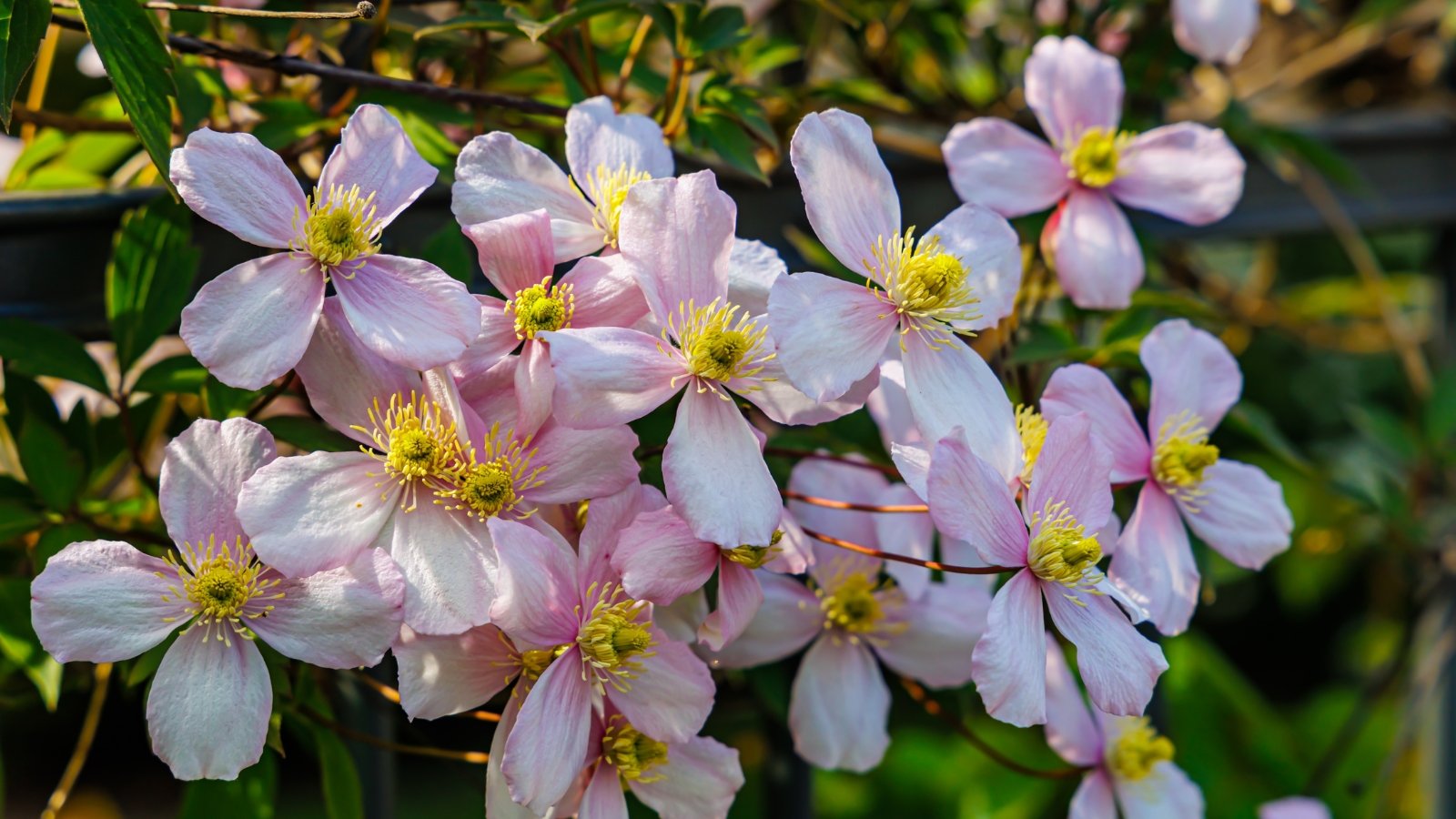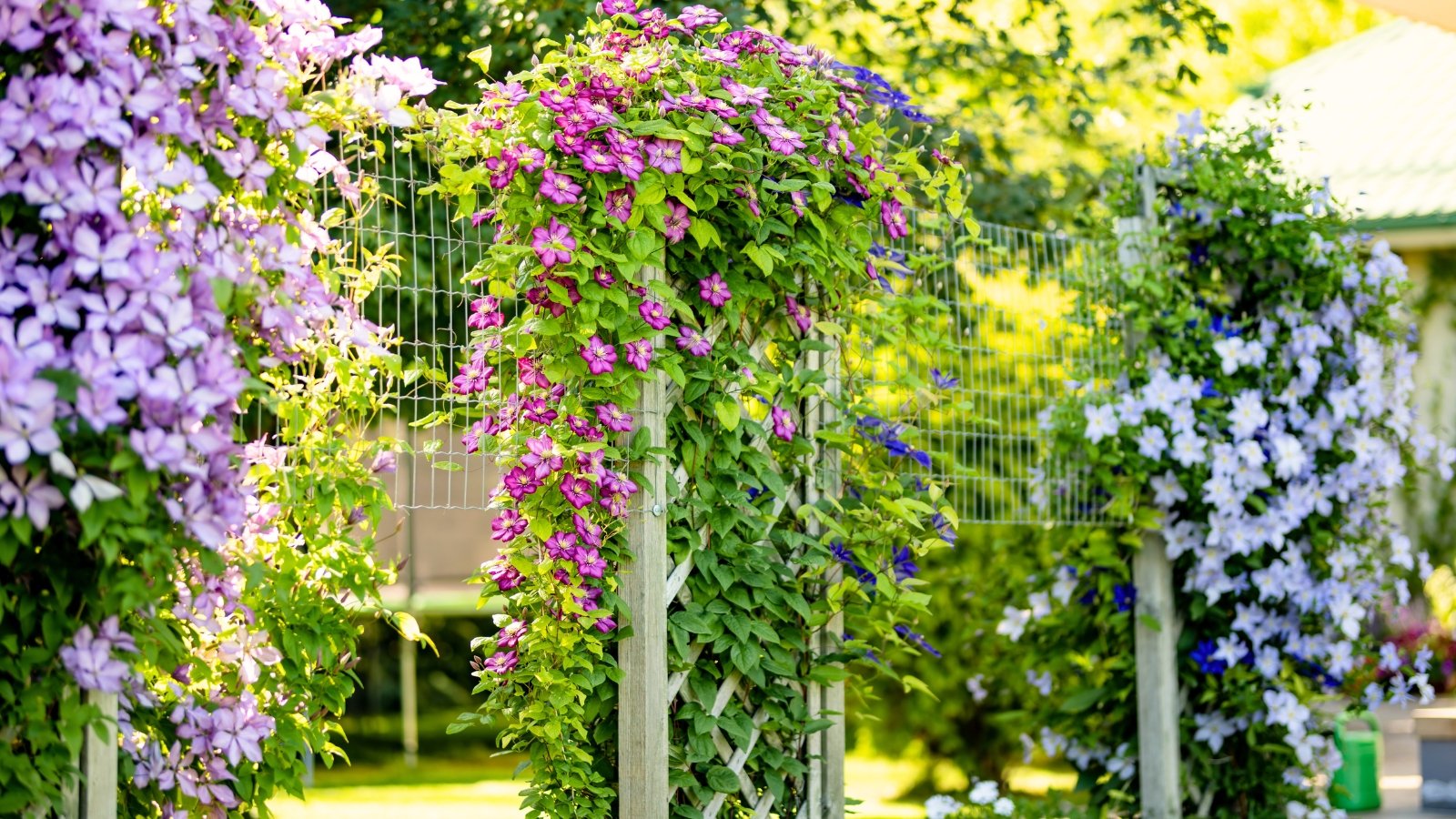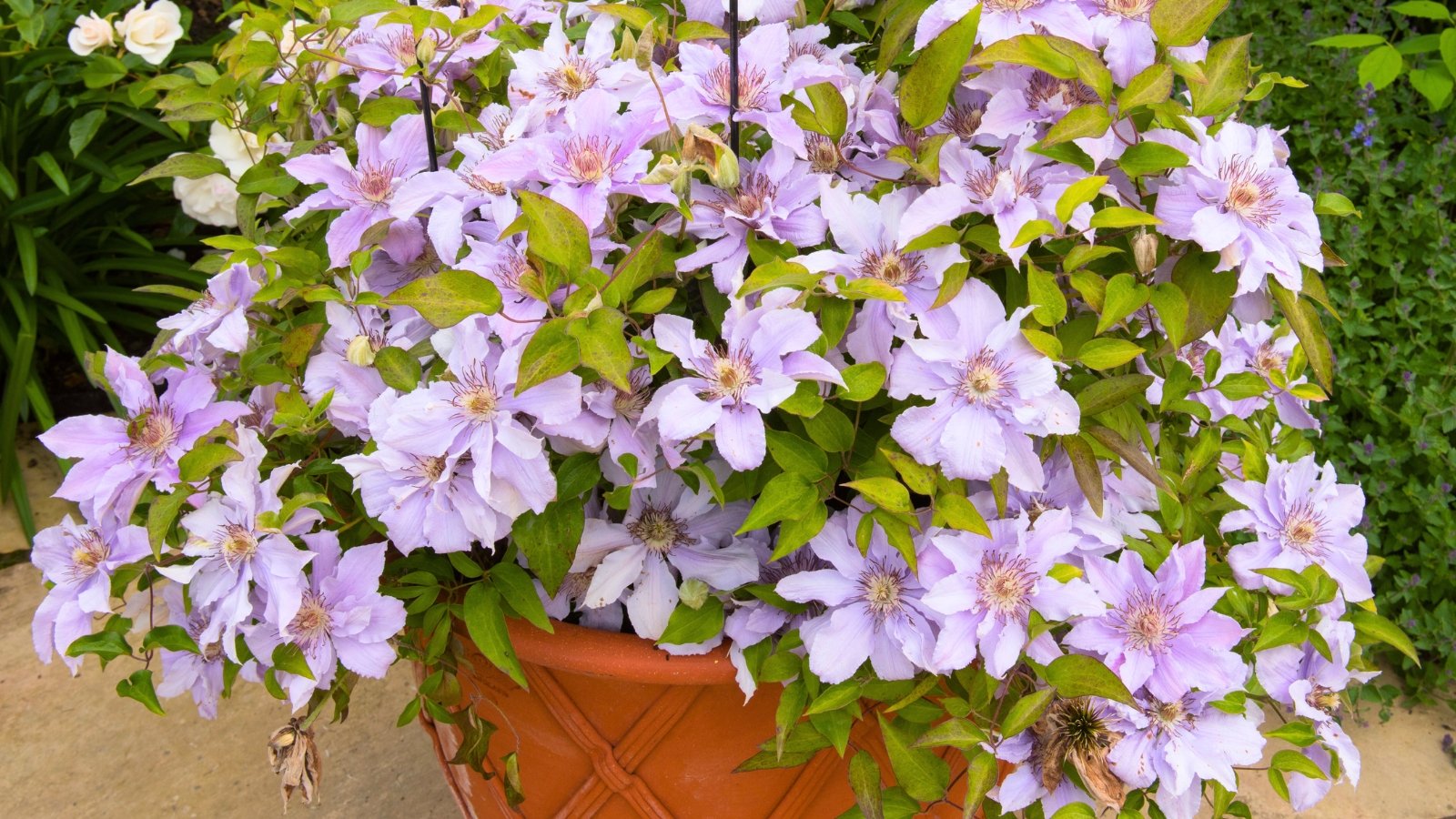PROTECT YOUR DNA WITH QUANTUM TECHNOLOGY
Orgo-Life the new way to the future Advertising by AdpathwayClematis is a quintessential garden favorite when it comes to flowering vines. In the right site, the perennials are long-lived. With over 250 species and thousands of cultivars, they have diverse flower forms, foliage, heights, and bloom times. The vines yield a flurry of violet, red, white, and pink shades from loose clusters, open blooms, or tight bells.
Clematis have different flowering times, beginning as early as late winter and extending through fall’s frost. The species are fragrant (hybrids less so), and the blooms attract pollinators.
Clematis are sensitive to root disturbance, making transplanting potentially stressful or damaging to established roots. When it comes to where to plant clematis, finding their ideal placement at the start sets them up for success.
Get to Know Your Variety
 Big hybrids tend to bloom twice, if pruned right.
Big hybrids tend to bloom twice, if pruned right.Because there are so many species and cultivars, it helps to know your particular variety for the best growth and care. Clematis are mostly woody, deciduous vines, but there’s also a handsome evergreen species (C. armandii) and smaller herbaceous types. These perennials bloom at different times with unique characteristics that relate to sun exposure, bud set, and pruning needs.
Providing the best cultural requirements for clematis builds strong root systems for robust vines. In its first two seasons, they may “sleep” and “creep” as their roots develop. By the third growing season, clematis “leaps” into graceful, full foliage with prolific blooms.
Early-flowering cultivars show color in spring and bloom on old wood. The buds begin developing shortly after flowering in the previous year. They overwinter and open in spring’s warming temperatures.
Large-flowered hybrids begin flowering in early summer from buds set the previous season, and also have repeat flowering on new stems. Late-flowering types bloom on the current season’s new growth in the summer, usually on the top two to three feet of the plant.
Provide the Best Light
 East-facing spots catch gentle morning rays just right.
East-facing spots catch gentle morning rays just right.Most species and their cultivars grow best in full sun, with at least six hours of sunlight daily. They’ll tolerate less, especially in hot climates, where morning sun and light afternoon shade protect leaves and stems from intense rays.
Some varieties fade in too much sun, including some red, blue, and bicolor large-colored hybrids. Morning sun or partial shade helps them retain full color throughout blooming.
Sun exposure is a key consideration for where to plant clematis. An eastern situation receiving that beneficial morning sun. Planting on the northern side of the house may result in too much shade, while the western side can mean harsh late-afternoon rays. A southerly position provides the most sunlight. It all depends on the surrounding trees, shrubs, and structures.
Observing the way the sun moves through the space is the best way to determine the right site (ensuring that protection from harsh midday sun).
Keep Roots Cool, Head in the Sun
 Mulch keeps roots comfy and soil just right.
Mulch keeps roots comfy and soil just right.Situate stems and leaves so they soak up the sun while letting roots stay cool and moist. To protect the wiry roots, provide a two-inch layer of mulch. Mulch helps regulate soil temperature and retain moisture. Bark chips, pine straw, and leaves work well as mulch material. Keep it off the stems to prevent diseases.
Low groundcovers and perennials also provide cooling shade at the ground level. Opt for those with shallow roots that won’t compete with the vine in close proximity. The leafy material helps insulate the roots and aids in moisture retention, too.
The aim is to keep the crown (base of the stems) and roots out of direct afternoon sun in the summer. Refresh the mulch each spring, giving the soil time to warm up post-winter.
Ample Airflow
 Pruning opens up the plant for better airflow and blooms.
Pruning opens up the plant for better airflow and blooms.Clematis needs good air circulation around leaves and stems to stave off fungal problems like powdery mildew, leaf spot, and clematis wilt. Allow space between the vines and structures like walls, with their supports placed several inches out for ventilation.
Situate the vines so they’re out of strong winds that can break the stems. Drying summer and winter winds also cause stress, from the foliage to the roots. In winter, frigid winds may damage old wood canes and buds, impacting the future flowering season.
Prune clematis according to whether they bloom on old wood, new wood, or both. Pruning woody stems helps open plants for increased air circulation, promotes new growth, and encourages reblooming. Know your type to determine the best pruning.
The Right Soil
 Well-prepared soil eases stress for slow-growing, sensitive roots.
Well-prepared soil eases stress for slow-growing, sensitive roots.Clematis grows and flowers best in moist, well-draining soils. They prefer organic compositions, and amending with compost at planting helps improve nutrition, aeration, drainage, and moisture retention. They’ll wither in prolonged soggy conditions, so if they’re placed near a downspout or low area, good drainage is essential. They benefit from one inch of water per week during the growing season (rainfall or irrigation), with supplemental water during dry spells.
Well-turned soil minimizes stress on clematis’ sensitive roots as they slowly establish. Dig a hole twice as large and deep as the nursery pot, and at least a foot wide and 18 inches deep to loosen the surrounding soil. Install the vine with the crown one to two inches below the soil level. This helps protect it for easy recovery in future seasons from animal damage, clematis wilt, and weather extremes.
Situate Vertical Supports
 Choose support size based on how tall vines will grow.
Choose support size based on how tall vines will grow.In determining where to plant clematis, consider that the climbing vines need a support structure to grow off the ground level. They’re beautiful on trellises, arbors, porch railings, obelisks, and along walls. They need thin supports for the base of the leaves to cling to. Leaf stems twine and rest on supports about ¼” thick.
Gridded wire makes a good support, with the openings between one and several inches wide. Cattle fencing and concrete reinforcing wire are pre-fab options, some with flexibility to wrap around posts for upward growth. Young plants benefit from a mini-trellis to train stems in the first year after transplanting. A flexible, small-gauge material like chicken wire adds support. Attach the mini-trellis to the larger one for a seamless transition as the vines grow.
Scale the trellis or other support to the variety’s mature vine length. Vigorous vines like C. armandii are gorgeous on an arbor, while smaller hybrids fit a low trellis or lattice support.
Trellises, Fences, and Walls
 Running vines along fences bring life to plain walls.
Running vines along fences bring life to plain walls.There are numerous options for where to plant clematis, whether letting them run along the ground as a flowering trailer or, more commonly, growing vertically. In the wild, they comingle with other specimens as they run and cling to nearby branches.
- Against a wall or fence – provide wire mesh or a trellis for vines to grow vertically, or let them run along the top of the wall.
- A multi-trunked tree or shrub lets them climb up thin branches; even dead specimen trees become interesting supports.
- Run them up a post or pole (porch, mailbox, light, etc.) – vines will need wire mesh or another small climbing structure to wrap around the fixture.
- Combined with other climbing plants on the structure (roses, flowering vines, running vegetables), they infill with seasonal blooms and elongated leaves.
In Pots and Containers
 Positioning the pot right makes all the growth difference.
Positioning the pot right makes all the growth difference.Clematis is a good fit for container culture, especially when it comes to compact selections with manageable vines. Install a support structure at planting to avoid disturbing the roots later on.
Provide a large container with good drainage holes, and use a quality potting mix (not garden soil). Formulated potting mixes are lighter with better aeration and drainage. Soils that are too dense in the pot cause weak root development. Topdress with a layer of compost or mulch for added insulation and moisture retention.
Situate the pot in the variety’s prime lighting location. Check moisture levels regularly, as clematis in containers dry out more quickly than in-ground specimens. Clematis overwinters in pots and containers with extra protection in cold climates.


 3 weeks ago
14
3 weeks ago
14





















 English (US) ·
English (US) ·  French (CA) ·
French (CA) ·